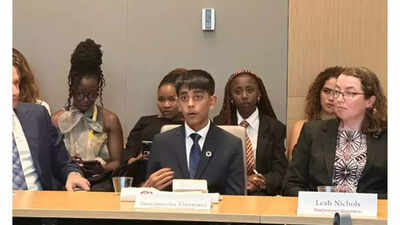A 17-year-old Indian-origin student, Siddhartha Patel Daswani, is gaining global recognition for using artificial intelligence to combat one of the planet’s most destructive environmental threats: wildfires. Through his initiative, SmokeSignal, Daswani has developed a suite of AI tools capable of detecting and predicting wildfires in real time, providing critical early warnings that can help save lives, forests, and ecosystems. What began as a childhood response to the 2017 Napa wildfires has now evolved into a global climate technology platform that blends AI innovation, youth education, and environmental policy advocacy, according to a report by The New India Abroad.
How the AI tool helps predict and prevent wildfires
Siddhartha’s journey began when he was just 10 years old, after massive wildfires in California darkened the skies above his home for days. That experience left a lasting mark. “For 36 hours, the sun disappeared,” he recalls. “That moment changed me. I knew I had to do something to prevent this from becoming normal.”Driven by that experience, Siddhartha founded SmokeSignal, a youth-led organisation using AI to identify smoke patterns and predict the spread of wildfires. The first model detects smoke from satellite imagery, providing early alerts without the need for expensive on-ground sensors. The second model, trained on over 831 million data points from six US government agencies, forecasts how fires will spread within 60 seconds.
How AI is reshaping wildfire management
SmokeSignal’s predictive tools go beyond traditional detection systems, offering real-time analysis that supports firefighters and emergency planners. The algorithms process massive environmental datasets, such as wind speed, vegetation type, and temperature, to forecast how a fire could evolve. This allows first responders to plan evacuations and containment strategies faster and more accurately.The organisation is now partnering with fire departments in Hawaii and California to field-test its AI detection system and aims to offer zero-cost access to more than 20 departments worldwide. By removing financial barriers, SmokeSignal seeks to ensure that developing countries can also benefit from the technology.
Beyond technology: turning awareness into action
Siddhartha’s vision extends beyond algorithms. SmokeSignal also focuses on education and community mobilisation, training young people to take local climate action. The organisation has hosted wildfire prevention seminars on four continents, from Los Angeles and Maui to Zambia, Argentina, and India.Its reforestation initiative, powered by over 50,000 youth volunteers, has already planted 45,000 trees across Kenya, India, and the US In addition, Daswani launched the “Be the Change Incubator”, which trains students across Asia, Africa, and North America to create their own sustainability projects.“Technology is powerful,” he says, “but when combined with education and community action, it becomes unstoppable.”
Global recognition and policy impact
Siddhartha’s work has attracted attention from both scientists and policymakers. Collaborating with Stanford University and the Santa Clara County FireSafe Council, he helped develop a new framework for prescribed burns that integrates Indigenous fire stewardship methods. This system has already been implemented in more than 100 controlled burns across 40,000 acres.His research also contributed to a federal climate policy brief proposing updates to the US Clean Air Act to include controlled burns as an official mitigation strategy. “Siddhartha is a wonderful young man, poised, thoughtful, and full of infectious enthusiasm for AI and wildfire prevention,” said Seth Schalet, CEO of the Santa Clara County FireSafe Council.
A global youth leader for climate innovation
Today, Daswani serves as the youngest honorary board member of the Santa Clara FireSafe Council and as a national ambassador for BAPS Charities, where he advocates for combining mindfulness and environmental responsibility. Through temple-based programs, he has inspired more than 200 children weekly to engage in environmental learning and service.As his AI systems expand globally, Siddhartha remains grounded in his mission. “Technology alone can’t solve the climate crisis; it’s people who make the difference,” he says. “My goal is to empower every young person to believe their ideas can save lives.” Go to Source


